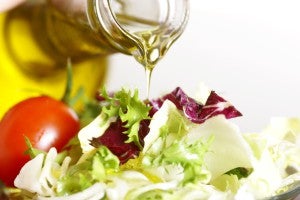 Swapping saturated fat and carbohydrates for linoleic acid – the main polyunsaturated fat found in vegetable oil, nuts, and seeds – lowers risk of coronary heart disease, according to a new study by Harvard School of Public Health researchers.
Swapping saturated fat and carbohydrates for linoleic acid – the main polyunsaturated fat found in vegetable oil, nuts, and seeds – lowers risk of coronary heart disease, according to a new study by Harvard School of Public Health researchers.
We talked to lead author Maryam Farvid, a visiting scientist and Takemi fellow in the Department of Nutrition, about the study to find out more.
1. Your research shows that by reducing the amount of saturated fat and carbohydrates we eat, and replacing those calories with foods rich in linoleic acid – such as vegetable oil, nuts, and seeds – we can reduce our risk of developing coronary heart disease. What’s so special about linoleic acid? And should consumers focus on reducing saturated fat and carbohydrates equally, or should we reduce one more than the other?
Replacing either saturated fat or carbohydrate with vegetable oils and seeing significant benefits indicates that reduction in saturated fat or carbohydrate is not the only reason for the beneficial effects of linoleic acid. Instead, linoleic acid itself plays a special role in support of heart health. Randomized clinical trials have shown that replacing saturated fat with linoleic acid reduces total and LDL cholesterol. There is also some evidence that linoleic acid improves insulin sensitivity and blood pressure.
2. Lately there’s been a lot of talk about healthy and unhealthy fats, with saturated fat being debated in the media. What can readers learn from your research about polyunsaturated versus saturated fats?
Our data provide strong support that substituting vegetable oils rich in polyunsaturated fat for saturated fat is beneficial for the prevention of coronary heart disease. The current debate about the role saturated fat misses an important point: the replacement nutrient. If saturated fat is replaced by carbohydrates (typically refined carbohydrates), there will be no benefit on heart disease. This is why many epidemiologic studies have failed to observe a significant association between saturated fat and risk of CHD as carbohydrates were typically used as a comparator. However, if saturated fat is replaced by polyunsaturated fat, then there is a clear benefit for heart disease prevention.
3. Is there a certain amount of linoleic acid consumers should aim to eat each day? What are the best sources?
Consistent with the American Heart Association guidelines, our data continue to support consumption of 5-10% energy intake from linoleic acid* to decrease CHD risk. Linoleic acid is the predominant n-6 polyunsaturated fatty acid (PUFA) in the Western diet and we can obtain it from vegetable oils such as sunflower, safflower, soybean, corn, and canola oils as well as nuts and seeds. A table spoon of soybean or corn oil contains about 7-8 g of linoleic acid, and 7 shelled walnuts provide about 11 g of linoleic acid. It should be noted that important sources of linoleic acid such as soybean and canola oils and walnuts also contain substantial amounts of alpha-linolenic acid, a plant-based omega-3 fatty acid.
*For example, for a 2,000 calorie diet that would equal 100-200 calories from linoleic acid.
4. Your study also addresses claims that linoleic acid is pro-inflammatory. Can you explain what you found when you researched this?
Concerns have been raised about higher linoleic acid consumption being harmful for heart health because of potential pro-inflammatory and thrombogenic properties. Linoleic acid can be elongated to arachidonic acid and subsequently synthesized to a variety of pro-inflammatory eicosanoids, which may increase CHD risk. But this speculation is not supported by randomized controlled feeding studies, in which dietary intake of linoleic acid was not found to increase plasma levels of arachidonic acid or inflammatory markers. On the contrary, some studies have found anti-inflammatory effects of diets higher in linoleic acid compared to those higher in saturated fat.
5. Based on this new study, what are some simple steps consumers can take to improve their diet?
Instead of using butter, cream, lard, and other animal fat as the primary source of culinary fat, one should use liquid vegetable oils like soybean, corn, olive, and canola oils for cooking, on salad and at the table. Although olive oil contains little linoleic acid, many studies have shown health benefits of Mediterranean diets rich in olive oil. Nuts and seeds are also excellent sources of healthy fats.
References
1. Farvid MS, Ding M, Pan A, Sun Q, Chiuve SE, Steffen LM, Willett WC, Hu FB. Dietary Linoleic Acid and Risk of Coronary Heart Disease: A Systematic Review and Meta-Analysis of Prospective Cohort Studies. Circulation. 2014

